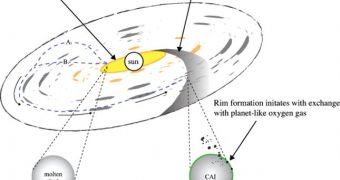A series of researches conducted on meteorites provided experts with a new understanding of what our solar system looked and behaved like in its earliest days. The work revealed that dust grains which eventually allowed for the formation of planets tended to bounce around a lot.
According to astronomers, the entire solar system was a massive game of pinball, in which particles were cast from one end to the other all the time. This happened some 4.6 billion years ago.
At that time, the planets had only begun forming, and looked nothing like they do today. The new meteorite study suggests that planetary formation may have been a process more complex than thought.
Scientists came to this conclusion after analyzing a small fragment recovered from a meteorite. The study revealed that the object most likely form around the Sun when the star was very little, and that it was then cast out to the fringes of the solar system.
The meteorite reached the current location of the asteroid belt, and then proceeded to return to the inner solar system afterwards. With this knowledge, experts can derive a better understanding of how the Sun's neighborhood looked like shortly after the star formed.
Additionally, the data could be used to make more sense of the processes involved with forming a planet in general. “This has implications for how our solar system and possibly other solar systems formed and how they evolved,” explains Justin Simon.
“There are a number of astrophysical models that attempt to explain the dynamics of planet formation in a protoplanetary disk, but they all have to explain the signature we find in this meteorite,” adds the NASA Johnson Space Center expert, who was also the lead author of the new study.
He and his group focused their efforts on a fragment of the Allende meteorite, a space object that impacted in Mexico in 1969. The pea-size fragment they analyzed is called a calcium-aluminum-rich inclusion (CAI), Space reports.
Usually, CAI can come together in space, forming meteorites such as Allende. According to space scientists, these inclusions are among the first types of solid matter to condense from the medium surrounding the early Sun.
“If you were this grain, you formed near the proto-Sun, then likely moved outward to a planet-forming environment, and then back toward the inner solar system or perhaps out of the plane of the disk,” Simon explains.
“Of course, you ended up as part of a meteorite, presumably in the asteroid belt, before you broke up and hit the Earth,” he adds, in a paper appearing in the March 4 issue of the top journal Science.

 14 DAY TRIAL //
14 DAY TRIAL //